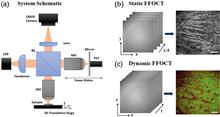Search by keywords or author
Journals >Chinese Optics Letters

Quantum Optics and Quantum Information
Yunyu Shao, Ziyi Shen, Yuehan Xu, Lang Li... and Guihua Zeng|Show fewer author(s)
Chinese Optics Letters
- Mar. 26, 2025
- Vol. 23, Issue 3 (2025)
Biophotonics
Keyi Fei, Bingying Lin, Zhongzhou Luo, Yupei Chen... and Peng Xiao|Show fewer author(s)
Chinese Optics Letters
- Mar. 26, 2025
- Vol. 23, Issue 3 (2025)
Lasers, Optical Amplifiers, and Laser Optics
Zhuoying Wang, Jie Zhao, Zizhuo Li, Zhenxing Sun... and Xiangfei Chen|Show fewer author(s)
Chinese Optics Letters
- Mar. 26, 2025
- Vol. 23, Issue 3 (2025)
Lasers, Optical Amplifiers, and Laser Optics
Ye Han, Kun Guo, Yizhen Zhu, Dong Wang... and Xudong Cui|Show fewer author(s)
Chinese Optics Letters
- Mar. 26, 2025
- Vol. 23, Issue 3 (2025)
Imaging Systems and Image Processing
Pan Zhang, Yuanyuan Liu, and Qiwen Zhan
Chinese Optics Letters
- Mar. 26, 2025
- Vol. 23, Issue 3 (2025)
Editors' Picks
The advanced equipment manufacturing industry demands high-precision, versatile, and multi-dimensional geometric measurements. Multi-channel laser ranging technology offers a unified sensing approach, minimal error sources, and high measurement efficiency. Frequency modulated continuous wave (FMCW) laser measurement technology, with its high precision, wide dynamic range, strong anti-interference capability, and high signal-to-noise ratio, enables precise absolute distance measurements of large-
Chinese Optics Letters
- Mar. 24, 2025
- Vol. 23, Issue 2 (2025)
Editors' Picks
Researchers from Peking University Yangtze Delta Institute of Optoelectronics, have proposed a universal design scheme for discrete whispering gallery mode (WGM) microcavity devices. The developed devices achieve an exceptional quality factor (Q) of up to 1 billion while maintaining remarkable robustness. On this platform, the team has successfully demonstrated low-threshold (4mW) and low-noise (-103dBc/Hz10kHz) soliton microcombs. This groundbreaking research provides an innovative technologica
Chinese Optics Letters
- Mar. 24, 2025
- Vol. 23, Issue 1 (2025)
Editors' Picks
Optical frequency combs (OFCs) are characterized by a comb-like structure in the frequency domain, where the frequency spacing between the comb teeth is equal, and the phases are mutually locked. OFCs have widespread applications in precision measurements, spectroscopy, and optical communications. In particular, in the field of microwave photonics, optical frequency combs serve as a bridge linking the optical frequency domain and the radio frequency (RF) domain. Among various OFC generation tech
Chinese Optics Letters
- Mar. 03, 2025
- Vol. 23, Issue 1 (2025)
On the Cover
Single-pixel imaging is an emerging computational imaging technology that, in contrast to traditional array detector imaging, utilizes a single point detector without spatial resolution capability to record image information. The single-point detector offers significant advantages, including low dark noise, high sensitivity, rapid response, and lower cost, while exhibiting excellent performance across nearly the entire spectral range. Due to its unique imaging mechanism, single-pixel imaging has
Chinese Optics Letters
- Feb. 18, 2025
- Vol. 23, Issue 1 (2025)
Top Downloads
- Chinese Optics Letters
- Vol. 22, Issue 10, 101203 (2024)
- Chinese Optics Letters
- Vol. 22, Issue 12, 120001 (2024)
- Chinese Optics Letters
- Vol. 22, Issue 10, 101404 (2024)
- Chinese Optics Letters
- Vol. 22, Issue 7, 073001 (2024)
- Chinese Optics Letters
- Vol. 22, Issue 9, 090001 (2024)
- Chinese Optics Letters
- Vol. 22, Issue 6, 063201 (2024)
Published
Editor (s): Haitao Liu, Lingling Huang, Yange Liu, Jiangbing Du... Weiwei Liu|Show fewer author(s)
Published
Editor (s): Chao Lyu, Songnian Fu, Bo Liu, Xinyuan Fang, Shanting Hu















